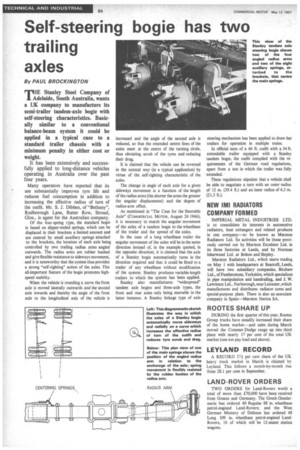Self-steering bogie has two trailing axles
Page 86

If you've noticed an error in this article please click here to report it so we can fix it.
By PAUL BROCKINGTON TE Stanley Steel Company of ilidelaide, South Australia, wants a UK company to manufacture its semi-trailer tandem-axle bogie with self-steering characteristics. Basically similar to a conventional balance-beam system it could be applied in a typical case to a standard trailer chassis with a minimum penalty in either cost or
weight.
It has been extensively and successfully applied to long-distance vehicles operating in Australia over the past four years.
Many operators have reported that its use substantially improves tyre life and reduces fuel consumption in addition to increasing the effective radius of turn of the outfit. Mr. S. J. Dibben, of "Bethany", Rodborough Lane, Butter Row, Stroud, Glos., is agent for the Australian company.
Of the four-spring type, the standard bogie is based on slipper-ended springs, which can be displaced in their brackets a limited amount and are centred by small auxiliary springs attached to the brackets, the location of each axle being controlled by two trailing radius arms angled outwards. The radius arms are rubber bushed and give flexible resistance to sideways movement, • and it is noteworthy that the system thus provides a strong "self-righting" action of the axles. This all-important feature of the bogie promotes highspeed stability.
When the vehicle is rounding a curve the front axle is moved laterally outwards and the second axle inwards and thereby the angle of the front axle to the longitudinal axis of the vehicle is increased and the angle of the second axle is reduced, so that the extended centre lines of the axles meet at the centre of the turning circle, thus obviating scrub of the tyres and reducing their drag.
It is claimed that the vehicle can be reversed in the normal way (in a typical application) by virtue of the self-righting characteristic of the axles.
The change in angle of each axle for a given sideways movement is a function of the length of the radius arms (the shorter the arms the greater the angular displacement) and the degree of radius-arm offset.
As mentioned in "The Case for the Steerable Axle" (COMMERCIAL MOTOR, August 26 1966), it is necessary to match the angular movement of the axles of a tandem bogie to the wheelbase of the trailer and the spread of the axles.
In the case of a long wheelbase trailer the angular movement of the axles will be in the same direction instead of, in the example quoted, in the opposite direction; it is claimed that the axle of a Stanley bogie automatically turns in the direction required and that it could be fitted to a trailer of any wheelbase without modification of the system. Stanley produces variable-length trailers to which the system has been applied.
Stanley also manufactures "widespread" tandem axle bogies and three-axle types, the front and rear axles only being steerable in the latter instance. A Stanley linkage type of axle steering mechanism has been applied to draw-bar trailers for operation in multiple trains.
In official tests of a 46 ft. outfit with a 34 ft. extendable trailer equipped with a Stanley tandem bogie, the outfit complied with the requirements of the German road regulations, apart from a test in which the trailer was fully " extended.
These regulations stipulate that a vehicle shall be able to negotiate a turn with an outer radius of 12 m. (39.4 ft.) and an inner radius of 6.5 tn. (21.3 ft.).
















































































































































































































































